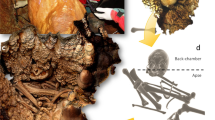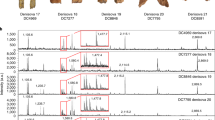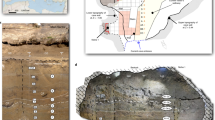Abstract
The successful retrieval of ancient DNA from two geographically dispersed Neanderthal skeletons1,2 has fuelled a demand for more Neanderthal DNA sequences for analysis. However, these exceptionally well-preserved specimens were geologically young and the mean annual temperature of their cave sites low, so the survival of this ancient DNA could have been due to unusually favourable conditions. Here we calculate the thermal history of a range of Holocene and Pleistocene bones whose DNA quality has been tested and find that in only very few sites with Neanderthal remains is the preservation of DNA likely to match the quality of that from the skeleton found at Mezmaiskaya Cave2. We recommend that any additional Neanderthal destined for destructive analysis should be carefully selected, taking into account its integrated thermal history.
Similar content being viewed by others
References
Krings, M. et al. Cell 90, 19–30 (1997).
Ovchinnikov, I. et al. Nature 404, 490–493 (2000).
Cooper, A. et al. Science 277, 5329–5332 (1997).
Leonard, J. A., Wayne, R. K. & Cooper, A. Proc. Natl Acad. Sci. USA 97, 1651–1654 (2000).
Höss, M., Pääbo, S. & Vereshchagin, N. K. Nature 370, 333 (1994).
Cooper, A. et al. Nature 381, 484 (1996).
Fleischer, R. C., Olson, S. L., James, H. F. & Cooper, A. C. Auk 117, 1055–1060 (2000).
Colson, I. B., Bailey, J. F., Vercauteren, M. & Sykes, B. C. Ancient Biomol. 1, 109–117 (1997).
Vandenberghe, J., Coope, R. & Kasse, K. J. Quat. Sci. 13, 361–366 (1998).
Guiot, J. et al. Palaeogeogr. Palaeoclimatol. Palaeoecol. 103, 73–93 (1993).
Elias, S. A. Quat. Res. 53, 229–235 (2000).
Lindahl, T. & Nyberg, B. Biochemistry 11, 3610–3618 (1972).
Zhang, T., Osterkamp, T. E. & Stamnes, K. Permafrost Periglac. Process. 8, 45–67 (1997).
Osborne, M. R. & Phillips, D. H. Chem. Res.Toxicol. 13, 257–261 (2000).
Author information
Authors and Affiliations
Corresponding author
Supplementary information
Rights and permissions
About this article
Cite this article
Smith, C., Chamberlain, A., Riley, M. et al. Not just old but old and cold?. Nature 410, 771–772 (2001). https://doi.org/10.1038/35071177
Issue Date:
DOI: https://doi.org/10.1038/35071177
- Springer Nature Limited
This article is cited by
-
Prokaryotic richness and diversity increased during Holocene glacier retreat and onset of an Antarctic Lake
Communications Earth & Environment (2024)
-
Limitations of eDNA analysis for Carcinus maenas abundance estimations
BMC Ecology and Evolution (2022)
-
Ethanol and sodium acetate as a preservation method to delay degradation of environmental DNA
Conservation Genetics Resources (2019)






